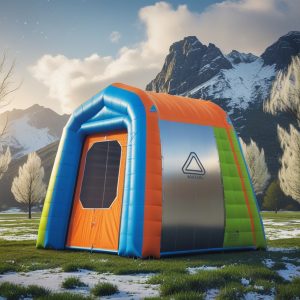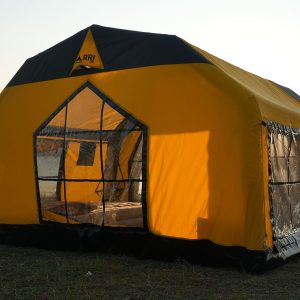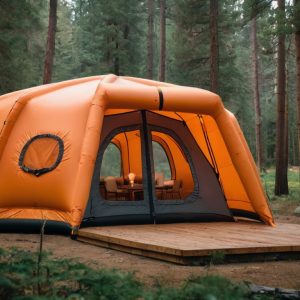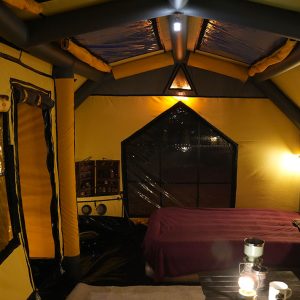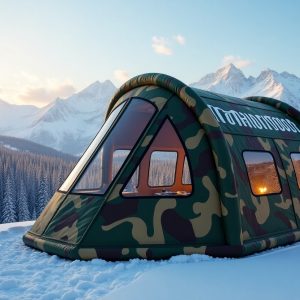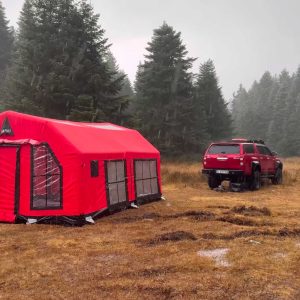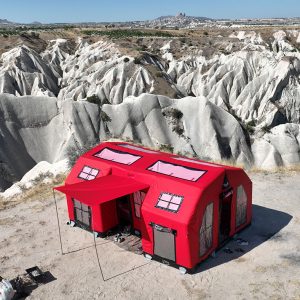
The Ultimate Guide to Inflatable Tents: The Future of Camping Comfort
Camping is one of the most rewarding outdoor experiences, allowing you to disconnect from the hustle and bustle of daily life and immerse yourself in nature. However, setting up traditional tents with poles and complex structures can be time-consuming and sometimes frustrating. Enter inflatable tents—a revolutionary concept that’s changing the way we camp. These modern shelters are designed for ease, convenience, and comfort, offering numerous benefits over traditional tents. In this article, we will explore the features, advantages, and why inflatable tents are quickly becoming the go-to choice for campers worldwide.
What Are Inflatable Tents?
Inflatable tents are a new breed of camping shelters that use inflatable beams or air-filled poles instead of traditional metal or fiberglass poles to provide structure and support. This unique design makes them faster to set up, more stable in various weather conditions, and often more durable than their conventional counterparts.
Inflatable tents come in various sizes and designs, ranging from small 2-person tents to large family tents that can accommodate up to 10 or more people. These tents are equipped with air beams that can be inflated using a pump, and once set up, they form a sturdy, weather-resistant shell that can withstand the elements.
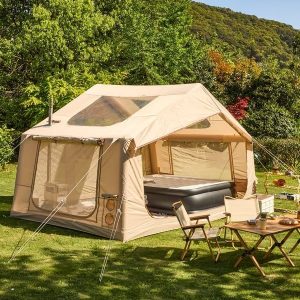
Key Features of Inflatable Tents
1. Quick Setup and Breakdown
One of the standout features of inflatable tents is the speed at which they can be set up. Unlike traditional tents that require you to manually assemble poles and stakes, inflatable tents are designed for rapid setup. You simply inflate the air beams, and your tent is ready in minutes. This ease of setup makes them ideal for both seasoned campers and beginners who may not want to spend time wrestling with poles.
2. Lightweight and Portable
Inflatable tents are generally lighter and more compact than traditional tents. Since they don’t rely on heavy poles, they are easier to carry, making them an excellent option for backpackers or anyone looking to minimize their load when camping. When packed up, they are often smaller and more convenient to store and transport.
3. Spacious and Comfortable
The design of inflatable tents allows for more internal space, providing greater comfort during your stay. With no rigid poles taking up space, the interior can be more open and roomy. This makes them an excellent option for families or groups who need more space to move around or store their gear. Many inflatable tents also feature larger doors and windows for ventilation, contributing to a more comfortable environment.
4. Durability and Stability
Inflatable tents are built to be robust and durable. The air beams used in the design provide added resistance against wind and rain. These tents are often made from high-quality materials such as Oxford fabric or polyester, which are waterproof, UV-resistant, and resistant to abrasion. Additionally, many inflatable tents are designed with reinforced seams and waterproof floors to ensure you stay dry, even during heavy rainfall.
5. Weather Resistance
Whether you’re camping in sunny conditions, rain, or wind, inflatable tents are designed to withstand the elements. The air beam structure makes the tent more flexible in windy conditions, reducing the risk of poles snapping or the tent collapsing under pressure. Many inflatable tents also come with fully waterproof coatings, keeping you dry during storms.
6. Innovative Design
Inflatable tents often come with modern designs that are both functional and aesthetically pleasing. Some models include large vestibules for extra storage, extended porches for sheltered outdoor space, and multiple rooms for added privacy. The flexibility in design also allows for features like air circulation systems, adjustable windows, and even built-in lighting in some premium models.
Advantages of Inflatable Tents Over Traditional Tents
1. Ease of Setup
One of the biggest frustrations with traditional tents is the setup process, especially when you’re tired or caught in bad weather. Inflatable tents eliminate this problem by offering a simple, hassle-free setup. Simply connect the pump, inflate the beams, and you’re done. No more struggling with poles, pegs, and complicated instructions.
2. Better Stability in Windy Conditions
Traditional tents with rigid poles can be vulnerable in strong winds, with the poles potentially bending or breaking. Inflatable tents, on the other hand, are designed to be more flexible and resistant to high winds, ensuring that your shelter remains stable and secure throughout the night.
3. Reduced Weight and Bulk
Traditional tents can be bulky and heavy, especially if they are large and made with numerous poles. Inflatable tents tend to be lighter and more compact, making them easier to transport, whether you’re hiking into a remote campsite or driving to a family campground.
4. Enhanced Comfort and Space
Because inflatable tents don’t require poles that take up internal space, the design allows for more room to move around. Many inflatable tents are spacious enough to fit multiple sleeping areas, extra gear, or even small furniture, offering a more comfortable camping experience compared to standard tents.
5. Long-Term Durability
Inflatable tents are generally made with strong, high-quality materials that are designed to last. The air beams used in these tents are more resistant to wear and tear compared to traditional poles, which can bend, break, or snap over time. With proper care, inflatable tents can provide years of reliable use.
Popular Use Cases for Inflatable Tents
• Family Camping: Inflatable tents are ideal for family camping trips, offering spacious interiors and quick setup so parents can spend more time enjoying the outdoors with their children.
• Festival Camping: Inflatable tents are a popular choice for festival-goers who need a fast, reliable shelter. Their ease of setup allows you to spend more time enjoying the event.
• Backpacking and Hiking: While they are generally lighter than traditional tents, larger inflatable tents may still be bulky for long-distance backpacking. However, smaller 1- or 2-person models can still be a great choice for hikers who prioritize ease of use and durability.
• Glamping (Glamorous Camping): For those who want to experience nature without sacrificing luxury, inflatable tents provide an excellent solution. They offer ample space and comfort, often with extra features like windows, ventilation, and even electricity options.
Conclusion: The Future of Camping
Inflatable tents are revolutionizing the camping industry, offering a blend of convenience, comfort, and durability that traditional tents cannot match. With their quick setup, lightweight portability, and weather-resistant features, they are quickly becoming a favorite for campers, festival-goers, and outdoor enthusiasts alike. Whether you’re embarking on a weekend family getaway or an extended hiking trip, an inflatable tent could be the perfect companion for your next adventure.
If you’re ready to experience camping like never before, it’s time to explore the world of inflatable tents. The ease of use, comfort, and reliability they provide will make your outdoor experiences even more enjoyable. Embrace the future of camping with an inflatable tent—you won’t look back!

 FARRI OUTDOOR | Inflatable Tents | Air Tents |
FARRI OUTDOOR | Inflatable Tents | Air Tents |

